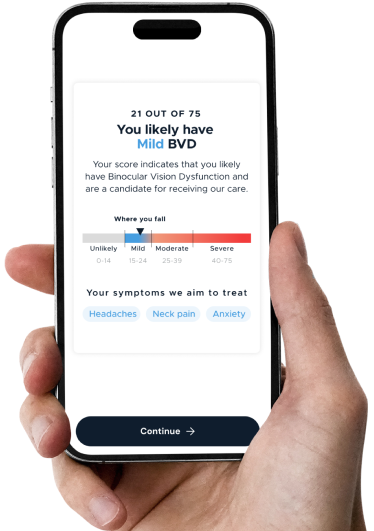Strabismus is a condition where the eyes are misaligned and fail to focus on the same point. It can cause double vision, eye strain, headaches, and poor depth perception. Affecting around 4% of Americans, strabismus can develop in childhood or adulthood and often requires specialized treatment.
What is Strabismus? (Misaligned Eyes)

Written by Mark Rosner, MD
Published: Dec 5, 2023Strabismus is a term that might not be immediately familiar to everyone, but it is a condition that affects a significant number of individuals worldwide. Understanding strabismus is crucial not only for those who have it but also for the general public as it sheds light on the complexities of vision and the importance of maintaining healthy eyes. In this article, we will delve into what strabismus is, its prevalence, symptoms, diagnosis, and treatment options. Moreover, we will explore its connection to Binocular Vision Dysfunction (BVD) and the significance of addressing both conditions.
What is Strabismus?
Strabismus is a visual condition characterized by the misalignment of the eyes causing double vision. In a healthy visual system, both eyes are supposed to work together to focus on an object, ensuring that the images seen by each eye are aligned and merged into a single, three-dimensional image in the brain. However, in individuals with strabismus, this coordination is disrupted, leading to double vision as one eye is looking straight ahead while the other may deviate inwards, outwards, upwards, or downwards.
Strabismus is more common than one might think, affecting approximately 4% of the population in the United States. It can develop in children and adults, and it doesn’t discriminate based on age, gender, or ethnicity.
Common Types of Strabismus
Strabismus can manifest in various forms of crossed eyes, with some of the most common types being:
- Esotropia: one eye deviates inward towards the nose.
- Exotropia: one eye deviates outward away from the nose.
- Hypertropia: one eye deviates upwards.
- Hypotropia: one eye deviates downwards.
The causes of strabismus can be multifaceted, with genetic factors, neurological issues, developmental problems, trauma, and certain medical conditions playing a role in its development.
Symptoms of Eye Misalignment
Recognizing the symptoms of strabismus is essential for early intervention and treatment. Common symptoms and consequences of strabismus include:
Misalignment of the eyes: If the misalignment is small, it may not be noticeable, but large amounts of misalignment result in visible deviation of one or both eyes.
Double vision (diplopia): Strabismus can cause a person to see two distinct images of an object, leading to discomfort and confusion.
Eye strain and fatigue: The constant effort required to align the eyes can result in eye strain and fatigue.
Headaches: Many individuals with strabismus experience frequent headaches, often related to eye strain.
Reduced depth perception: The eyes working together are essential for depth perception. Strabismus can hinder this ability, making tasks like judging distances difficult.
Impact on daily activities: Strabismus can affect a person’s ability to perform everyday tasks such as reading, driving, or even recognizing faces.
Psychological and social effects: Strabismus can lead to self-esteem issues, social anxiety, and a reluctance to make eye contact with others.
Diagnosis of Strabismus
If you suspect strabismus in yourself or a loved one, it is essential to seek professional evaluation and complete an eye examination. A comprehensive eye examination conducted by an optometrist or ophthalmologist is the first step in diagnosis. This examination includes assessing eye alignment, measuring binocular vision, evaluating visual acuity, and checking for any underlying eye conditions.
In some cases, individuals may be referred to a NeuroVisual Medicine specialist who will focus on strabismus and related visual disorders. Early diagnosis is crucial, as it allows for timely intervention and the development of a tailored treatment plan.
Strabismus Treatment
The treatment of strabismus depends on several factors, including the type and severity of the condition. Treatment options may include:
Non-surgical approaches
Eyeglasses: In some cases, the use of corrective lenses containing prism can help alleviate strabismus by assisting the eyes in focusing correctly.
Vision therapy: Vision therapy involves eye muscle exercises and techniques designed to improve eye coordination and alignment. It can be especially effective in children with strabismus to help them control eye movement.
Surgical options
Strabismus surgery: In cases where non-surgical treatments are ineffective, surgery may be recommended to reposition or adjust the eye muscles, allowing for better alignment.
Combination treatments
In many instances, a combination of non-surgical and surgical approaches may be necessary to treat strabismus and achieve the best results. Each treatment plan is individualized to the patient’s specific needs.
Prognosis and Expected Outcomes
The prognosis for strabismus varies depending on factors such as age at diagnosis, the severity of the condition, and the effectiveness of treatment. With early intervention and appropriate treatment for the misaligned eye, many individuals with strabismus can achieve improved eye alignment, better visual function, and a higher quality of life.
Connection to Binocular Vision Dysfunction (BVD)
Binocular Vision Dysfunction (BVD) is a condition where the eyes do not work together efficiently, affecting binocular vision. Binocular vision is essential for depth perception, eye teaming, and visual comfort.
Individuals with BVD often exhibit symptoms that overlap with those of strabismus, such as double vision, eye strain, and headaches. This means that sometimes people with BVD are unknowingly misdiagnosed with strabismus.
Recognizing and addressing BVD in individuals is crucial. Working with a NeuroVisual Medicine specialist can help you get the proper diagnosis and alleviate BVD symptoms with prescription prism lenses.
Strabismus or BVD? A NeuroVisual Medicine Specialist Can Help
Strabismus is a common visual condition that can affect individuals of all ages. Binocular Vision Dysfunction is another very common condition that people across the world struggle with. Understanding the nature, symptoms, diagnosis, and treatment options for these conditions is essential for improving the quality of life for those living with them. With early intervention and tailored treatment plans, individuals with strabismus or BVD can lead fulfilling lives with improved vision and visual comfort.
NeuroVisual Medicine specialists diagnose and treat BVD. Start by taking the BVDQ™ Assessment to learn if BVD is causing your symptoms.



